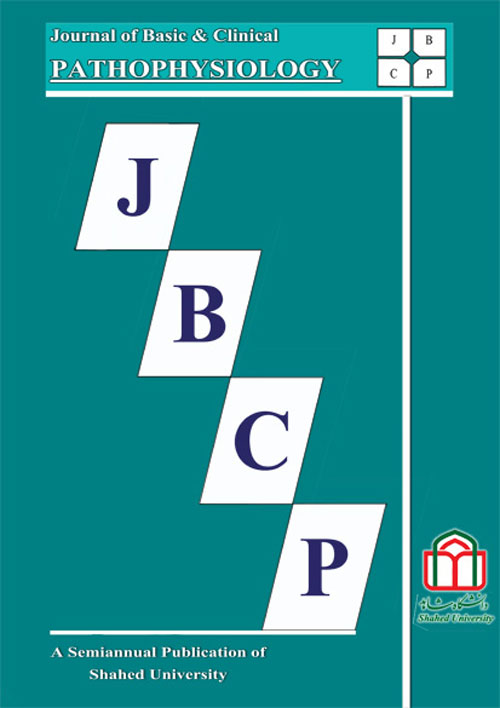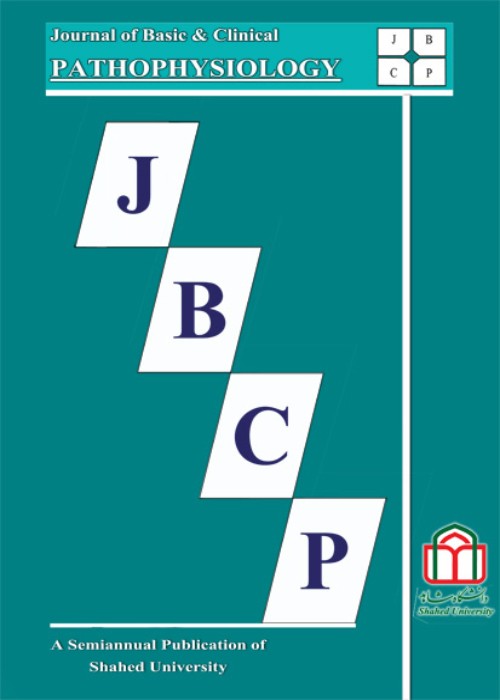فهرست مطالب

Journal of Basic & Clinical Pathophysiology
Volume:6 Issue: 2, Summer-Autumn 2018
- تاریخ انتشار: 1397/08/13
- تعداد عناوین: 6
-
-
Pages 1-6Background and ObjectiveMigraines are the third most prevalent diseases and the seventh most debilitating diseases in the world. Medical treatment options for acute migraine episodes are various while none are infinitely effective for all patients. The aim of the present study was to compare fixed combination of acetaminophen, aspirin and caffeine with ibuprofen (AAC) with ibuprofen.Materials and MethodsThis double-blind clinical trial (Registration No. IRCT2017052930680N4) was performed upon patients attending the neurology clinic at Shahid Mostafa Khomeini General Hospital with complaint of headache. Treatment protocol for this study consisted of 2 medications prescribed for 4 consecutive episodes: Ibuprofen 400 mg and AAC tablets. Each patient received two sets of medication each for two episodes of headaches consisting of 2 of each drug. Pain perception was evaluated by 11-point Box Scale at three stages: prior to administration of the medication, and 2 and 6 hours after taking the medications and daily functions of the patient were assessed 6 hours after administering the medications by filling the Behavioral Rating Scale (BRS-6) which is a clinical assessment tool.ResultsResults of this study demonstrated that difference in severity of pain after taking 2 Ibuprofen tablets and AAC in the first and second episodes of migraine was statistically significant. Furthermore, AAC as compared to Ibuprofen, helped considerably more by allowing patients to regain enough focus to continue their daily life (P=0.001).ConclusionThe results of this study showed that in patients with migraine, AAC is more effective than ibuprofen on improving patient's function and reducing pain.Keywords: Migraine disorders, Acetaminophen, Aspirin, Caffeine, Ibuprofen, Treatment
-
Pages 7-12Background and ObjectiveDoxorubicin is one of the most common drugs for chemotherapy. The complications of doxorubicin are cardiac toxicity due to oxidative stress. Cydonia oblonga Miller leaf (COL) contains flavonoids and phenolic antioxidants. Due to the presence of antioxidant compounds in COL, the aim of this study was to evaluate the effect of hydroalcoholic extract of COL on doxorubicin-induced cardiac injury in rat.Materials and MethodsIn this experimental investigation, 32 male Wistar rats were divided into 4 groups: control, control under treatment of hydroalcoholic extract of COL, doxorubicin and doxorubicin under treatment of hydroalcoholic extract of COL. In treatment groups, 200 mg/kg of hydroalcoholic extract of COL was injected intraperitoneally one hour after the first dose of doxorubicin for 2 weeks and administered daily. For induction of cardiac toxicity, doxorubicin was injected at a dose of 15 mg/kg intraperitoneally. After two weeks of treatment, the rats were anesthetized with diethyl ether and their heart was removed. After tissue homogenate was prepared, oxidative stress markers were measured using specific kits.ResultsThe results of this study demonstrated that doxorubicin increases malondialdehyde and reduced glutathione and catalase activity in the cardiac tissue of rats. Two weeks of treatment with hydroalcoholic extract of COL significantly reduced the malondialdehyde level and increased glutathione. The increase in catalase activity was not statistically significant.ConclusionAccording to the results of this study, COL with phenolic and flavonoid compounds and antioxidant activity seems to attenuate lipid peroxidation and oxidative stress in doxorubicin induced cardiac toxicity.Keywords: Doxorubicin, Cydonia oblonga Miller leaf, Cardiac toxicity, Oxidative stress, Rat
-
Pages 13-16Background and ObjectiveThe presence of the resistant bacteria in different wards of hospitals and problems which are thereby made by these organisms in treating patients specify the necessity to identify this type of bacteria and their antibiotic resistance pattern.Materials and MethodsIn this cross-sectional study, the resistance related to 60 samples of the isolated Acintobacter baumanii was gathered from three different hospitals of Tehran and they were studied in relation to six new antibiotic groups. Antibiotic sensitivity of the selected samples were also measured based on the disk diffusion method, and then it was reviewed by the CLSI table. The studied data were finally examined using the software SPSS 16 and Reference tests.ResultsThe study findings showed that piperacillin-tazobactam antibiotic has the minimum rate of sensitivity with 86.7% resistance, and with 30% resistance, a combination of ampicillin-sulbactam is of the maximum sensitivity.ConclusionIn this study, strains isolated from the patients showed a high resistance as compared to three antibiotics, and they were placed in species resisted to some drugs. Treating such infections can be considered as a great challenge to physicians.Keywords: Acinetobactor baumanii, Antibiotic resistance, Tigecycline, Piperacillin-tazobactam
-
Pages 17-22Background and ObjectiveChlorogenic acid (CGA) is a major polyphenolic component of coffee. Reduction in the risk of a variety of diseases following CGA consumption has been mentioned in recent studies. The effect of CGA on learning and memory in rats with cognitive deficit induced by intracerebroventricular streptozotocin (STZ) and acetylchoinesterase (AChE) activity was evaluated in this study.Materials and MethodsFor this purpose, 32 male Wistar rats (250-290 g) were divided into four different groups as: control, control plus CGA, STZ treated group, and CGA-treated STZ group. STZ was injected (bilaterally, 3 mg/kg body weight, on days 1 and 3). CGA was administered through intraperitoneal route at a dose of 50 mg/kg for 14 days started one week after STZ injection. To evaluate the spatial learning and memory, Y maze (alternation behavior) and passive avoidance tests were used. Finally, AChE activity was measured via specific kits in hippocampal homogenate.ResultsCGA-treated STZ group did not show significant improvement in spontaneous alternation behavior as compared to STZ group. In passive avoidance test, there was significant difference between STZ and CGA-treated STZ groups. In the latter group, learning and memory was improved. In STZ group, AChE activity as compared to control group significantly increased and treatment with CGA significantly decreased the levels of AChE.ConclusionAdministration of CGA can improve learning and memory in passive avoidance test with apparently no improvement of spatial memory. Also, CGA can modulate the AChE activity in the hippocampus. Therefore, these results demonstrate the effectiveness of CGA in preventing part of cognitive deficits caused by ICV STZ in rats and also show its potential in the treatment of neurodegenerative diseases such as Alzheimer’s disease.Keywords: Chlorogenic acid, Streptozotocin, Learning, memory, Alzheimer’s disease
-
Pages 23-26Background and ObjectiveDepression is a common disorder, especially in developed countries. Functional changes of cholinesterase are involved in pathogenesis of some brain disorders. Until now, exact association of these changes with depression has not been determined. This study was conducted to evaluate the changes of serum cholinesterase in lipopolysaccharide (LPS)-induced model of depression in male mice.Materials and MethodsMale mice (n = 48) were divided into 2 groups of control and LPS. For induction of depression, LPS (0.5 mg/kg; i.p.) was injected 24 h before the experiments. Open field, forced swimming, and tail suspension tests were used for behavioral assessment. Finally, serum cholinesterase activity was determined using biochemical method.ResultsLPS injection significantly decreased travelled distance in open field test (p<0.05) and increased immobility duration in forced swimming and tail suspension tests (p<0.01). In addition, serum cholinesterase showed a significant decrease in LPS subgroups versus control (p<0.05).ConclusionOur data showed that LPS could induce a valid model of depression and changes of cholinesterase are in part involved in development of its complications.Keywords: Depression, Lipopolysaccharide, Cholinesterase
-
Pages 27-31Background and ObjectiveElectroconvulsive therapy (ECT) is one of the effective and less complicated methods for treatment of depression in cases of resistance to common treatments. Given the fundamental role of pre-frontal cortex on changing the mood of depression-related behaviors in depressed patients, the effects of electroconvulsive therapy on enzymatic activity of this cortex were taken into account in this study.Materials and MethodsFor this purpose, 42 male Wistar rats were divided into three control, depressed and ECT groups. To create depression, Chronic Unpredictable Mild Stress (CUMS) method was used. Finally, NO, MDA, GSH and SOD in prefrontal portion of the brain in three mentioned groups were measuredResultsOur findings showed a non-significant increase of MDA (p>0.05) in both groups of depress and ECT in comparison with control. ECT caused a significant increase in contents of GSH and SOD in prefrontal cortex versus the group of control. Also, ECT significantly increased the level of nitrite as compared with control.ConclusionTreatment of depression by ECT could increase the level of antioxidants in the depressed rats' brain and it may be considered as a treatment for moderate depression disorders.Keywords: Depression, Electroconvulsive therapy, Oxidative stress, Rat


